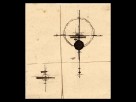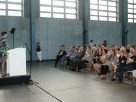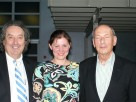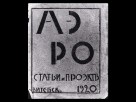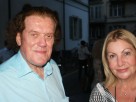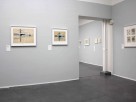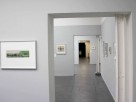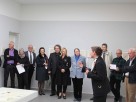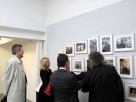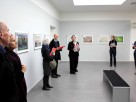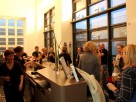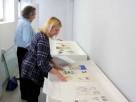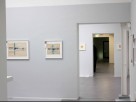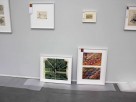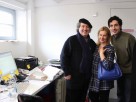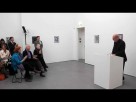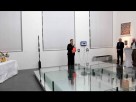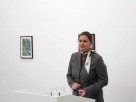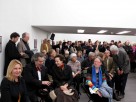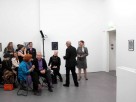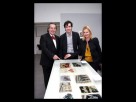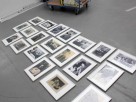Lazar Markovich Khidekel, Rediscovered Suprematist 1
Event Venue:
Haus KonstruktivSelnaustrasse 25, CH-8001
Zurich, Switzerland
Event Date:
August 27, 2010 to January 30, 2011On view from: installment 1 minimal-maximal - August 27 to October 31, 2010
installment 2 metamorphoses - November 11, 2010 to January 30, 2011
"Lazar Markovich Khidekel – the Rediscovered Suprematist", a solo exhibition from the artist's estate, is a part of the COMPLETE CONCRETE, an exhibition on the 100-year of development constructivist, concrete and conceptual art and its effect on the present.
The exhibition COMPLETE CONCRETE is subdivided into two installments with varies solo and group exhibits:
installment 1 minimal-maximal - August 27 to October 31, 2010
installment 2 metamorphoses - November 11, 2010 to January 30, 2011.
Lazar Khidekel (1904 in Vitebsk – 1986 in Saint Petersburg, formerly Leningrad), artist and architect, is one of the most important representatives of the Russian avant-garde in the 1920s.
Haus Konstruktiv is delighted to provide comprehensive access to Lazar Khidekel's works, including drawings and paintings which have hardly ever been shown previously, for a broad public in Europe for the first time. Over 150 sketches, drawings, original plans, documents and paintings which coherently document his development from cubo-futurism to suprematism, through to his urban development designs for a "green city" (which from today's perspective come across as quite spectacularly current) can be seen. In addition, they are exhibiting around 40 true-to-life sketches, in which he addresses fashion, everyday objects and (humorously) his own hairstyle.
Already as a teenager, Khidekel followed the art movement of suprematism, a type of art freed from references to objects, reduced to the simplest geometric forms and thus demonstrating elementary human principles of cognition. Russian suprematism formed one of the key foundation stones for the art of the 20th and 21st centuries.
Lazar Khidekel's career resembles a paradigm for an artist's existence in the environment of the Russian avant-garde: like Marc Chagall, Lazar Khidekel is also born into an Orthodox Jewish working-class family in Vitebsk. Due to the outbreak of the revolution in 1917, Khidekel cannot complete secondary school. In 1918, at 14 years of age, he applies to the local art school with paintings and drawings – and is accepted. He is taught by Marc Chagall – the founder of the school – as well as by El Lissitzky and Kazimir Malevich. Already in 1920, Khidekel writes his manifesto "AERO". In this piece of writing, with a passionate tone throughout, the young artist advocates a green city, in which the modern human being is to live in harmony with nature. This topic shall occupy Khidekel for his entire life.
AERO. Articles and Projects, Vitebsk, 1920 is the earliest example of multifaceted manifesto through which Artist expresses his philosophical views on Art as an emerging conceptual framework, new futuristic vision and pioneering views on looming ecological impact of modern civilization. It is for the first time, Lazar Khidekel (16-years old student of Vitebsk Art School and the Unovis founding member) defines his artworks not as art per se but as conceptual project supported by literary statements that would truly change reality by introducing new forms and even semantics through which we should comprehend new approaches to art. It is in AERO where Lazar Khidekel first proposes his views on ecology as crucial element for any new architectural expression that would not just conquer nature by forcing it into workable shape and matter but through new futuristic solutions that could allow humanity to harmoniously coexist with nature. AERO. Articles and Projects, Vitebsk, 1920, has been included in the "timeline" which guides the public through decades from 1910 to 2010, thus forming the foundation of the presentation. "Timeline" is presented at a permanent show on the museum's ground floor, which remains unchanged for the entire five months of the exhibition COMPLETE CONCRETE run.
After completing his study of architecture at the end of the 1920s, he goes on to become one of the most renowned architects in Russia and also makes a name for himself as a professor of architecture.
To this day, little attention is paid to Lazar Khidekel internationally and his work has seldom been mentioned or shown in exhibitions in the past decades. Although one of the reasons for this is the slow progress of critical incorporation of the Russian avant-garde, another is that its second generation has often gone unnoticed in art history. Because unlike Malevich, who returned to representational painting after his suprematist phase, Khidekel developed the themes of suprematism further and, above all, also integrated them into his urbanist concepts. Thus, the exhibition "The rediscovered suprematist" honors not only a captivating and artistically extra-ordinary body of work, it also indirectly addresses the question of how and why subsequent generations pick up on a theme and develop it further, and primarily, how this development is to be evaluated in the context of art history. Without a doubt, Khidekel is one of the most important representatives of the Russian avant-garde, despite the young age at which he committed himself to suprematism. And he continued this legacy until his death in 1986.
Khidekel's art works and unprecedented archive of documents survived the tumultuous years of Leningrad siege during the WWII and Stalin'’s purges. It is purely thanks to the dedication of Lazar's son Mark Khidekel, an architect and urban designer in his own right, along with his wife Regina Khidekel, an art historian with a profound knowledge of Russian art history, that Lazar Khidekel's estate has been kept together to this day. Regina Khidekel has been critically incorporating it within the context of art history for a number of years and it offers a quite inexhaustible resource from which to obtain a deeper understanding of suprematism.
The Lazar Khidekel solo exhibition is a result of close cooperation with Mark, Regina and their son Roman Khidekel.
To read the Museum's press release, click here Press Release
For more information, visit www.HausKonstruktiv.ch
Curator: Dorothea Strauss
Monday, January 24, 2011, 6:30 pm
Regina Khidekel: On the visionary power of Russian suprematism
Regina Khidekel, art historian and exhibition organiser currently living in New York, looks after the estate of Lazar Khidekel together with her husband Mark Khidekel, the son of this Russian artist. Lazar Khidekel, born in Vitebsk in 1904, was one of Kazimir Malevich's students at that city's legendary art school founded by Marc Chagall and is part of the second generation of Russian suprematists. In her lecture, Regina Khidekel addresses the significance of Khidekel's work, sheds light on how Jewish culture in Vitebsk influenced the development of suprematism and presents the art-historical context of the period around 1920. The lecture is to be held in English and is realised in cooperation with OMANUT, an organisation promoting Jewish culture in Switzerland. Dorothea Strauss, director and curator of the Lazar Khidekel exhibition, shall give a brief introduction.
November 27, 2010 - Schweizer Illustrierte
Keineswegs Kleinkariert
by Kati Moser
(in German)
http://www.schweizer-illustrierte.ch/kultur/keineswegs-kleinkariertl
To read this article as a PDF, click here
November 18, 2010 - Neue Zürcher Zeitung
Avantgardistische Kunst – losgelöst von allem Irdischen
by Brigitte Ulmer
(in German)
http://www.nzz.ch/nachrichten/kultur/zuercher_kultur/avantgardistische_kunst__losgeloest_von_allem_irdischen_1.8414780.html
To read this article as a PDF, click here
More Information: http://www.HausKonstruktiv.ch


